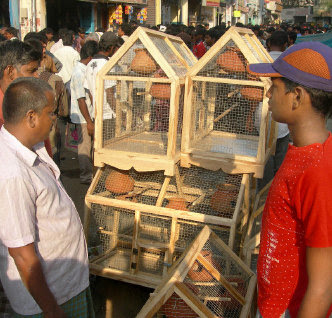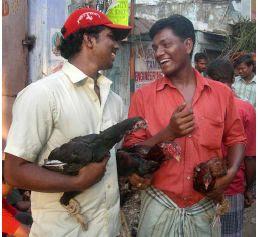planning to have this as a series. let c how this goes. lets start with Maskan Chavady
One day in the life of ... Maskan Chavady: Pet destination. Every Sunday, Maskan Chavady turns into a bazaar for birds and animals. PRINCE FREDERICK hangs around
 Traders at Maskan Chavady are wary of reporters. Three years ago, rooster-sellers went into silence at the sight of my scribble-pad. So this time around, I leave pen and paper behind but dress up for this special assignment. After my alarm clock duti fully wakes me at five in the morning, I get into a canary green polo-neck T-shirt with a block-printed image of a pigeon and catch what is probably the first morning bus in my neck of the woods. From Parry’s Corner, I hire an auto for a Sunday morning date with birds and beasts. Nobody gives me a second look, thanks to my canary green T-shirt. Good for me, the milling crowd thinks I am one of their own.
Traders at Maskan Chavady are wary of reporters. Three years ago, rooster-sellers went into silence at the sight of my scribble-pad. So this time around, I leave pen and paper behind but dress up for this special assignment. After my alarm clock duti fully wakes me at five in the morning, I get into a canary green polo-neck T-shirt with a block-printed image of a pigeon and catch what is probably the first morning bus in my neck of the woods. From Parry’s Corner, I hire an auto for a Sunday morning date with birds and beasts. Nobody gives me a second look, thanks to my canary green T-shirt. Good for me, the milling crowd thinks I am one of their own.Attempt at history
I show an interest in homing pigeons, offered by Ravi at Rs. 200 a pair. When I try to beat down the price, he says his price is fair. Apparently, he keeps pigeons as a hobby, selling some to maintain the rest. When he reduces the price to Rs. 100 a pair, I tell him I am not interested. That I am a journalist looking for a story.
 Ravi introduces me to 71-year-old Mohan, touted as the best bet to throw light on the market’s origins. But Maskan Chavady existed even before Mohan began to sell pigeons as a 10-year-old. As it turns out, he is not very informed about the market’s history.
Ravi introduces me to 71-year-old Mohan, touted as the best bet to throw light on the market’s origins. But Maskan Chavady existed even before Mohan began to sell pigeons as a 10-year-old. As it turns out, he is not very informed about the market’s history.
The bazaar is sustained by the passion of pet lovers. Many travel long distances to be here. The traders take a lot of trouble too. Duck-seller Kumar pedals from Vadakkarai (beyond Red Hills) after ingeniously piling cages high on his cycle carrier. However, Nakeeran tops the list for enthusiasm. He can’t use his legs and with a cycle made for the handicapped, he travels slowly from Old Washermanpet to sell rabbits. And there is always someone new entering the fold. Rajkumar is just knee high to a grasshopper. But this boy has come (escorted by 17-year-old Elvis, his neighbour and ‘anna’) to trade in white mice today (at Rs. 30 a pair).
 It is 8.30 a.m. and two hours of chatting and walking around is beginning to tell on me. I am badly in need of my morning coffee and something to chew on. For small change, Nagoor offers me a cup from the steel can he carries around on a cycle. And I depend on Samikanu from Korukupet for breakfast – gruel made from ragi. As pet lovers and traders leave home early, these mobile eateries do brisk business till the last man leaves.
It is 8.30 a.m. and two hours of chatting and walking around is beginning to tell on me. I am badly in need of my morning coffee and something to chew on. For small change, Nagoor offers me a cup from the steel can he carries around on a cycle. And I depend on Samikanu from Korukupet for breakfast – gruel made from ragi. As pet lovers and traders leave home early, these mobile eateries do brisk business till the last man leaves.
I decide to buy myself a memento from Maskan Chavady. There are bird cages, which I will require shortly for a mini-aviary I have been planning for my little son. The one I take a fancy for costs Rs. 900, more than what I carry with me to the market.
I sit on my haunches and inspect a pile of catapults spread out on a cardboard. I end up buying one for Rs. 15 from Kumar, a gypsy who makes them using rubber meant for surgical appliances.
As I leave the market with this keepsake tucked in my pocket, I can’t help thinking, “This is interesting! Nobody knows when it started. Nobody can lay claim to any space. It is not controlled by rules, yet there is order.”
Credits:
Thanks to : Metro Plus, The Hindu
Photos & Story: Prince Frederick, The Hindu
Comments
pirainila